I recently found out that the first gaming NFTs date all the way back to 2015. After digging into their history for a couple of hours I was instantly hooked and decided to add a bunch of them to my collection. With the help of many other NFT Archeologists, I wrote this story in an attempt to educate more people about them. I’ve also sprinkled in a little bit of my current thinking on NFTs and how I approach investing in them. I hope y’all enjoy it.
Humanity is embarking on an adventure into the metaverse but in order for us to build a brighter future we must first understand our past. This is the story of how it all began…
In June of 1992, Neal Stephenson published the science fiction novel Snow Crash, which presented a profound vision for a future iteration of the internet made up of shared, 3D virtual spaces linked into a perceived virtual universe. He called it the "metaverse". Snow Crash went on to capture the imagination of millions of readers worldwide and has come to be renowned as one of the most forward-thinking pieces of science fiction literature.
Fast forward 22 years to December 19th, 2014 when a young iOS developer in Japan by the name of Christian Moss released a game on the App Store called SaruTobi where you tapped the screen to spin a monkey to see how far you could get him to fly. Christian wanted to let SaruTobi players purchase in-game items with Bitcoin but Apple’s iOS App Store terms didn't allow it so instead he let players collect small amounts of Bitcoin as they played. And just like that, one of the first play-to-earn games was born.

Meanwhile, across the world in Switzerland, an indie game studio called EverdreamSoft began work on their upcoming game Spells of Genesis. In a stroke of genius, the founder, Shaban Shaame, had the idea to store the game's cards on a blockchain rather than a centralized server. On March 11, 2015, the company released the first Spells of Genesis card, FDCARD, on Counterparty, a financial platform built on top of the Bitcoin blockchain. For the first time ever, the scarcity of an in-game item was guaranteed and players were given true ownership. By tokenizing FDCARD, it became the first-ever gaming NFT.
That event marked the beginning of a rising tide that would eventually lead gamers and social media users to reclaim power from their centralized overlords. Shaban didn’t realize it at the time, but he had just ushered in a new era of gaming that would eventually lead to millions of people working full-time inside of games and earning billions of dollars a year. Several months later, on June 24, 2015 EverdreamSoft released the Spells of Genesis SATOSHICARD, the most powerful, and second most scarce, card in the game. It was the first-ever NFT depicting Satoshi.
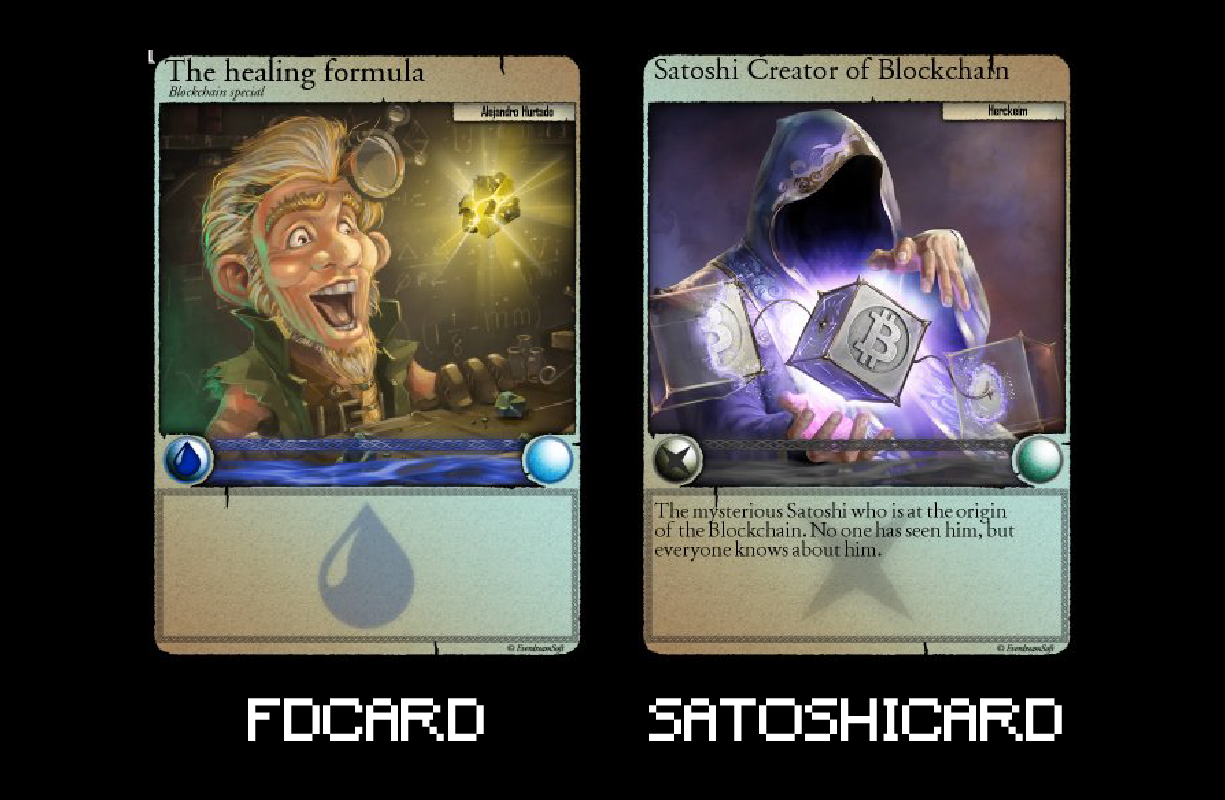
EverdreamSoft would go on to release a total of 156 cards over the course of several years. Spells of Genesis would not be released until 2017, but while it was under development, EverdreamSoft decided to make FDCARD playable within their previous game, Moonga, in April 2015. This marked the first instance of interoperability where an NFT was integrated into two games made by the same developer. Interested readers can learn more in this post about it on the bitcointalk forum: https://bitcointalk.org/index.php?topic=1043281.0
All of the Spells of Genesis cards were inspired by events and other projects spanning blockchain history. For example, GOXCARD pays homage to the infamous Mt. Gox hack. The team at EverdreamSoft had caught wind of a fun mobile play-to-earn game that was quickly rising in popularity among the early Bitcoin community called SaruTobi. And on December 19, 2015, exactly one year after SaruTobi had launched, the SoG SARUTOBICARD was minted. Little did Shaban know, he had just set in motion the events that would intertwine the fates of these two games forever.
On the other side of the world, in Tokyo, Christian heard about SARUTOBICARD and what Spells of Genesis was doing by tokenizing in-game assets as NFTs and thought it was cool. On May 6, 2016, he created the first native NFT to SaruTobi called NINJASUIT. NINJASUIT became the first NFT skin, the first NFT power-up, and it marked the first instance of an NFT being used in a play-to-earn game.
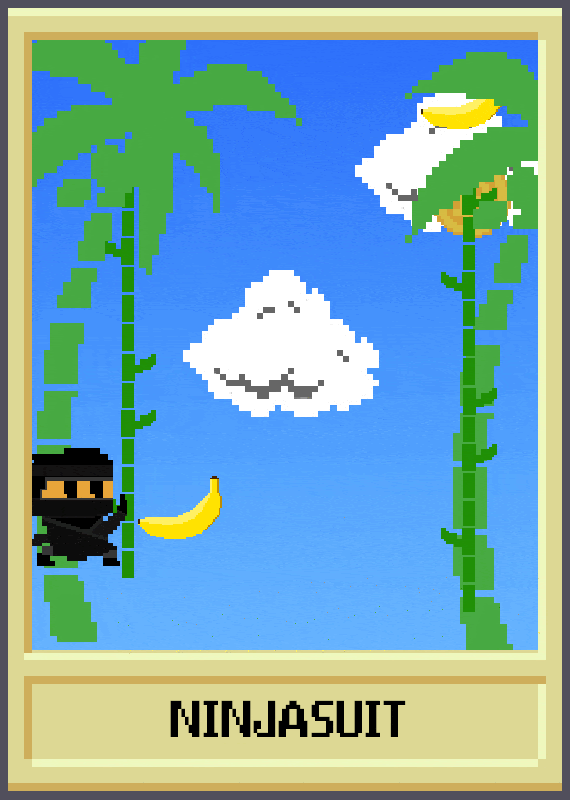
The only other NFT native to SaruTobi would be minted one year later, called STBNIMBUS. Christian also had the ingenious revelation that he could “attract [the Spells of Genesis] user base over to my game by offering use of their game items.” He realized that he could “link their Counterparty mobile wallet to SaruTobi and SaruTobi would be able to read what tokens they had in their wallet. Based on their token inventory I could grant access to various features in the game.” In June of 2016, Christian implemented this functionality by making the Spells of Genesis SATOSHICARD, SARUTOBICARD, and CNPCARD playable in Sarutobi. This marked the first instance of a tokenized asset becoming interoperable between two independent games.
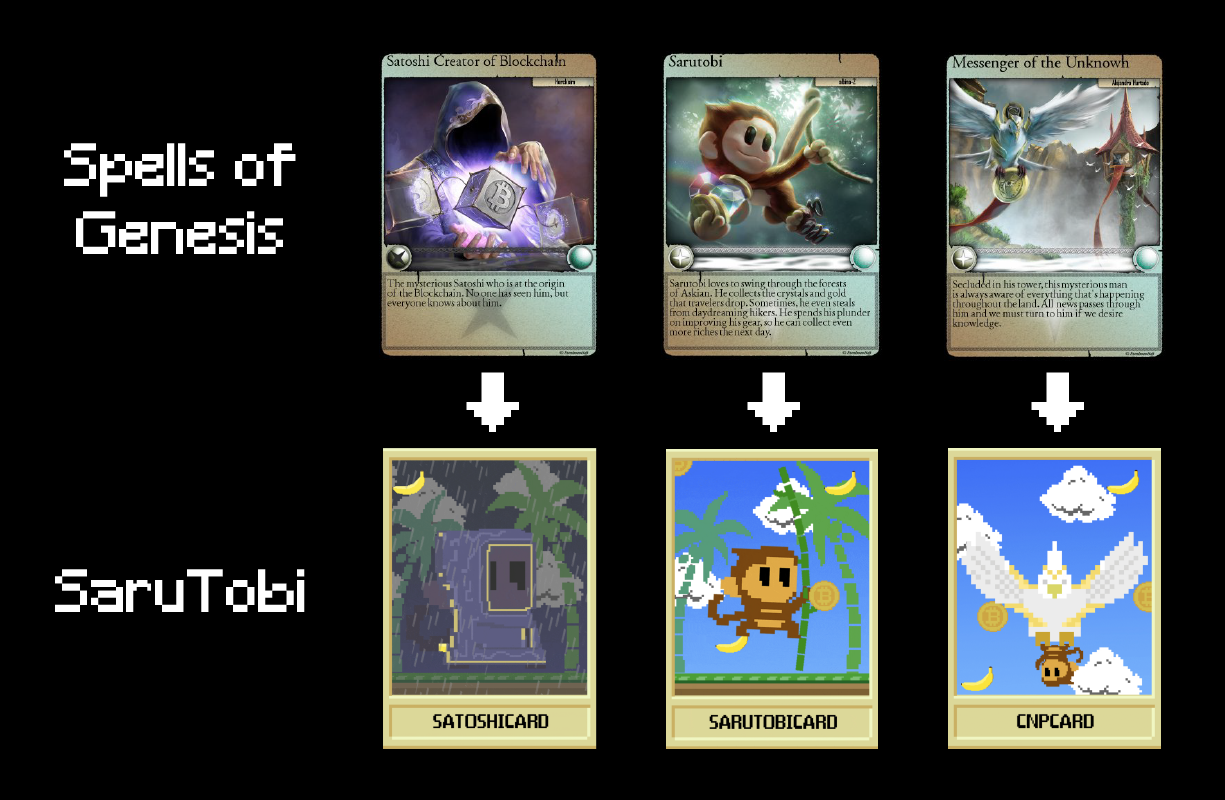
In this humble moment of serendipity when the three SoG cards were used interoperably in SaruTobi, the first crack in the walled gardens of the multi-trillion dollar gaming and social media industries appeared, and from the ashes of its Web 2.0 predecessor, the metaverse was born.
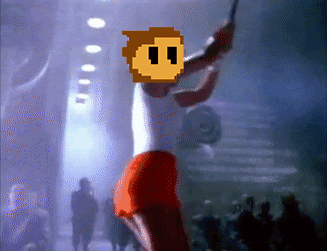
The significance of this moment will not be fully understood until those walls of the gaming and social media industries come crumbling down. It is also worth mentioning that, later on, both ZAIFCARD and ETHEREUMCARD from Spells of Genesis were integrated into SaruTobi, but each for a very short amount of time as part of promotions.
Several months later, Rare Pepes started to take off and Christian noticed that they only had utility as collectibles. So he decided to submit a card to the project for review and on October 17, 2016 the Rare Pepe SARUTOBIPEPE card was minted.
In another instance of interoperability, Christian allowed SaruTobi users who held SARUTOBIPEPE in their wallets to unlock a special skin in the game. By doing so, SARUTOBIPEPE became the first playable Rare Pepe.

I can’t help but feel like this was foreshadowing for what is to come for collectible projects like CryptoPunks. Once you understand the power of interoperability and composability, and you come to fully appreciate that two images can be the same NFT, you'll understand why so many invest in PFP projects.

One day, Christian was having a chat with his friend Koji Higashi, another active developer in the Bitcoin NFT space, when they had the epiphany that it would be possible to let players combine two different NFTs to spawn something random. From this conversation, the idea for the game SaruTobi Island was born, and on August 26, 2017 it was released on the iOS App Store.
SaruTobi Island players were able to combine two of the Counterparty NFTs in their wallet to generate a random monster in the game. Of course, this idea would later be popularized by projects like CryptoKitties, with breeding, and Bored Ape Yacht Club, with Mutant Apes. Even more importantly, SaruTobi Island was the first instance of an NFT character “coming to life” and being released into a 3D world. Given the direction that gaming and social experiences are heading, I believe this moment is historically significant.

In the future, I expect many PFP projects will come to life as 3D avatars in the metaverse and that they will probably grant members access to exclusive spaces. When people trace back the history, all roads will lead back to the story of Spells of Genesis and SaruTobi NFTs. Christian made all of the NFTs from SaruTobi also playable in SaruTobi Island in addition to issuing four more cards: KOSMOCD, MACHANCD, MANDELDUCKCD and SARUTOBIISL. (It is worth noting that SARUTOBIISL is not native to SaruTobi Island because Christian actually minted it for a project called MemoryChain and then used it interoperably in SaruTobi Island.)
Now you might be asking yourself what exactly is interoperability and composability and why does this Leo dude seem to think they are so darn important? Well, all you really need to understand about interoperability in this context is that it means that the ownership of a digital asset can transfer across multiple different apps and games permissionlessly. This means users aren’t locked into a single app or game. For example, if the bean bag chair company Lovesac shuts down, the giant chair in my living room doesn’t just vanish, because it is an asset that I own and is distinct from its producer. Neither should our in-game assets or followers vanish if games and applications become defunct.
The power of interoperability is that we could pick up our NFT in-game assets or followers and go elsewhere if we are not happy. Absolute power corrupts absolutely—centralized services will do everything in their power to keep their take rates high and continue printing money. And, to be honest, they can’t be blamed. That’s exactly what the incentive alignment in our current system encourages them to do. Through true ownership and interoperability, we are less likely to be screwed by corporations. Right now, users are held hostage by the closed networks they have chosen to be part of. The cost to leave is simply too high. But with interoperability, organizations will be forced to act in the best interest of users, otherwise they will walk away and take what they can with them. Interoperability is about shifting power away from centralized platforms and back to users.
Vitalik Buterin, one of the co-founders of Ethereum, gets it: “I happily played World of Warcraft during 2007-2010, but one day Blizzard removed the damage component from my beloved warlock's Siphon Life spell. I cried myself to sleep, and on that day I realized what horrors centralized services can bring.”
Another important piece of the metaverse is composability. All this means is that developers should be able to build anything they want onto an existing NFT. A token should be a permissionless, blank canvas for all future developers to work off of. For example, the character SaruTobi is just an idea that is imbued onto the SARUTOBICARD. EverdreamSoft first gave it utility in Spells of Genesis and then, without permission, Christian took the character and gave it new functionality within his game. In the future, when studios like Blizzard Entertainment inevitably build games like World of Warcraft on a blockchain, I believe that they will use the composable property of NFTs to make existing characters like SaruTobi unlock features in their games. It will be an expectation of users that their CryptoPunks, Apes and CrypToadz travel with them throughout every game and social experience, unlocking cool new features in each one. Given that, my thesis is that the developers of all these future games might just give the characters used in the first blockchain games and the first instances of interoperability a little something special. Because of this, I think our cute little SaruTobi character (which means “flying monkey” in Japanese) might just become the next Pikachu or Mario. Who knows! The value of an NFT is not just its current utility but because of interoperability and composability, you also have to include the value of all future utility that an infinite number of people can build on top of. This is an incredibly powerful concept and I believe that it justifies the need for a new framework when valuing this emerging NFT asset class which is:
NFTs are the new IP: All of the future value of the SaruTobi characters won’t be captured by someone who holds the intellectual copyrights to them. The value will be captured by the people and DAOs who are fortunate enough to hold a SARUTOBICARD NFT or any of the other assets related to it. So in this new model where NFTs are the new IP, how do we know what to invest in? Well, it’s the same as it’s always been.
We invest in stories: Investing in stories will probably mint a new wave of billionaires. Ask yourself how compelling is the story behind an NFT? Does it capture your imagination? Does it create an emotional bond between holders? These are the right questions to be asking. I don’t care that the NFTs from this story only have a community of a hundred people. I don’t care that there aren’t huge influencers on board yet. I bought all of these NFTs because of the story that they tell when you put them together. All I care about is the story. And the story and historical significance are sort of the same thing. People seem to really love the stories about the first projects that do something innovative and push the boundaries. The first PFP projects are worth a lot more than the thousands that followed. Being early and/or historically significant also provides additional value. The underlying utility of all NFTs is their ability to store value, and scarcity plays a critical role in that. Because of their creation timestamp, early NFTs create very strong scarcity. As my friend @WRabbit1111 likes to say: “There is no limit to the supply of tokenized assets that will emerge in the future, but there is an iron-clad hard cap on the scarcity of those in the past.”
We see this same phenomenon play out in tangible collectible assets like retro video games, antique cars, wine, watches, baseball cards, etc. So why would it be any different in the digital age?
There is a pretty obvious long-term bull case for the NFTs mentioned in this story. Just hold for a decade or two until billions of people are living, working and gaming in the metaverse. It’s probably inevitable that they will eventually become tremendously valuable. But there is also an intriguing short-term bull case cropping up. The drumbeat on the metaverse has slowly been getting louder and louder but it reached a new level in recent weeks when Facebook changed its name to “Meta” and released that viral 77-minute video. In response to it, seemingly overnight, the market’s demand for metaverse investments quadrupled. Just look at this graph of Decentraland’s $MANA token.
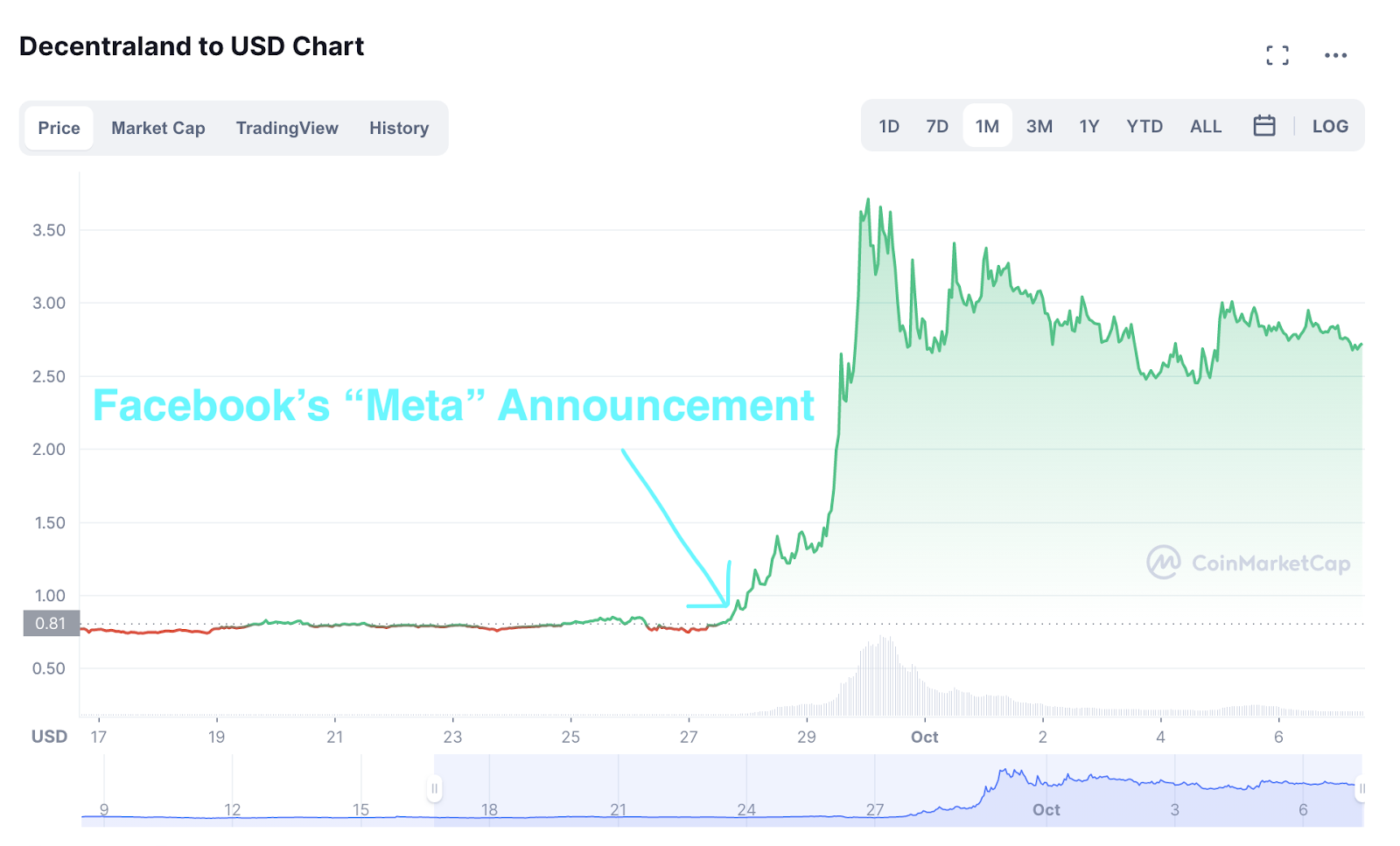
The bottom line is that there is massive pent-up demand for metaverse investments and many billions of dollars are flowing to projects that seem like the best play. I would imagine that if this story about the birth of the metaverse gets out there and if the market is savvy enough to understand that NFTs are the “new IP” because of interoperability/composability, things could potentially get crazy pretty fast. But like I always say: I have no clue if the market is going to go up, down, sideways or do a backflip in the short run, but I do know that historically significant NFTs like these will almost certainly be valuable in the long run so those who are patient will be rewarded. My message to anybody looking to get metaverse exposure is simple. In the last speculative frenzy about a protocol (the dot-com bubble), people tried to pick websites. Now they are trying to pick tokens. But just like how in 1999 a grand total of 0 people envisioned Uber or Snapchat, nobody knows which game or project will be relevant in 10 years. So why pick when you can just invest in the interoperable tokens with a kickass story that will be relevant no matter what?
In time, when billions of people are living, working and gaming in the metaverse, The Legend of SaruTobi may come to be known by every gamer and metaverse citizen alike and the NFTs that are part of this story will be some of the most coveted. We have the opportunity to usher in a future brighter than any of us could ever imagine and by just sharing this story with one another we are bringing ourselves one step closer to that future.
A bridge has recently been built between Counterparty and Ethereum so now all of the NFTs in this story can be moved back and forth freely and can now be traded on OpenSea.
Go follow the early NFT pioneers involved in this story:
Christian Moss (@MandelDuck): Creator of SaruTobi & SaruTobi Island
Shaban Shaame (@shaban_shaame): Founder of @EverdreamSoft & @SpellsofGenesis
Koji Higashi (@Coin_and_Peace): Developer of Book of Orbs mobile NFT wallet
Also, Adam McBride and I recently hosted a Twitter Space with Shaban and Christian so if you are interested in learning more about Spells of Genesis and SaruTobi go check out the recording on his podcast, The Adam McBride Show, which is available everywhere you listen to podcasts.
Also, @nishseq made an awesome two-minute video about this story and did a ridiculously generous giveaway alongside it. Go check it out.
Also, come drop by the Discords and say hi!
SaruTobi Community: https://discord.gg/nyK2Dw8UjD
SoG Community: https://discord.gg/3SFF6s4aU6
SoG Trading Community: https://discord.gg/UDpzkG2vtj
Rare Pepe Community: https://discord.gg/FqsteJRdXf
NFT Archaeology Community: https://discord.gg/fa55fhaYaw
The Discords are a great place to ask questions! Buying bridged assets can initially be a little intimidating but it’s actually pretty simple and there are plenty of people in these communities who are more than willing to help you get started.
I want to give a huge shoutout to all of the people who helped me gather all of the facts to piece this story together. Thank you, @nishseq, @WRabbit1111, @equ1l1br1um_, @killakoins, and the dozen or so others who contributed.
If you’re looking to learn more about the metaverse and why I believe it’s inevitable go check out my previous Twitter thread.
Now for those interested in the 13 historically significant Spells of Genesis, SaruTobi and Rare Pepe NFTs mentioned in this story. All of them combined have a market cap of roughly $70 million USD at the time of writing. To put that into perspective, they are worth less than a random new 10k PFP project with a 1.5Ξ floor. If you believe in the same metaverse/play-to-earn/cross-chain/multi-chain future that I do, then you will probably see why I believe that these NFTs are significantly undervalued. Additionally, the Emblem Vault team is working on some major UX improvements that will make these assets easily discoverable on OS very soon, just like any other NFT project. If you’re looking to see some of the recent bridged NFT sales on OS greater than 2Ξ, @EmblemVaultBot is a great resource.
In this Tweet, I have listed all of the Spells of Genesis and SaruTobi NFTs (ordered by mint date) that were part of this story and the humble beginnings of blockchain gaming and the birth of the metaverse so be sure to check them out. I hope y’all found this story as interesting as I did, and if you have any questions, my DMs are always open: @LeonidasNFT


